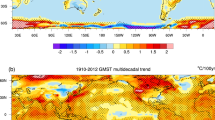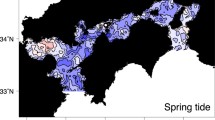Abstract
With the understanding that seasonal cycle of the temperature is forced principally by the annually evolving solar irradiance, many previous studies have defined seasonal cycle of surface air temperature (SAT) as the sum of yearly-period sinusoidal component and its harmonics, especially semiannual component. This perception of directly forced response is confirmed for tropical SAT in this study. However, in mid-latitude and subpolar oceans, the ratio between the semiannual and annual components of solar irradiance is negligibly small but that of the SAT over oceans is not, which remains to be understood. To solve this puzzle, a simple energy budget model including main energy sources and sinks of oceanic mixed layer is designed. It is revealed that, when the oceanic mixed layer is prescribed as a layer of constant depth, the phase and amplitude of the modeled SAT are not consistent with these of observations. However, when the annually changing heat capacity of oceanic mixed layer is included, both the amplitude and phase of the modeled SAT share these of the observed SAT, proving that the semiannual component of SAT over mid-latitude and subpolar oceans is a result of the heat capacity-varying oceanic mixed layer in response to annually evolving solar irradiance.





Similar content being viewed by others
Data Availability
The data used to support the finding are cited within the article.
References
van den Broeke MR (1998) The semi-annual oscillation and antarctic climate. Part 1: influence on near surface temperatures (1957–79). Antarct Sci 10:175–183
Cronin MF, Pelland NA, Emerson SR et al (2015) Estimating diffusivity from the mixed layer heat and salt balances in the North acific. J Geophys Res: Oceans 120(11):7346–7362
Deser C, Alexander MA, Timlin MS (1996) Upper-ocean thermal variations in the north pacific during 1970–1991. J Clim 9(8):1840–1855
Donohoe A, Dawson E, McMurdie L et al (2020) Seasonal asymmetries in the lag between insolation and surface temperature. J Clim 33(10):3921–3945
Dwyer JG, Biasutti M, Sobel AH (2012) Projected changes in the seasonal cycle of surface temperature. J Clim 25(18):6359–6374
Fiedler PC, Philbrick V, Chavez FP (1991) Oceanic upwelling and productivity in the eastern tropical pacific. Limnol Oceanogr 36(8):1834–1850
Gaspar P (1988) Modeling the seasonal cycle of the upper ocean. J Phys Oceanogr 18(2):161–180
Godfrey J, Lindstrom E (1989) The heat budget of the equatorial western pacific surface mixed layer. J Geophys Res: Oceans 94(C6):8007–8017
Gordon AL (1981) Seasonality of southern ocean sea ice. J Geophys Res: Oceans 86(C5):4193–4197
Holbrook NJ, Bindoff NL (1999) Seasonal temperature variability in the upper southwest pacific ocean. J Phys Oceanogr 29(3):366–381
Hori M, Aoki T, Tanikawa T et al (2006) In-situ measured spectral directional emissivity of snow and ice in the 8-\(14 \mu \text{ m }\) atmospheric window. Remote Sens Environ 100(4):486–502
Houghton HG (1954) On the annual heat balance of the northern hemisphere. J Meteor 11(1):1–9
Idso SB (1970) The transmittance of the atmosphere for solar radiation on individual clear days. J Appl Meteor 9(2):239–241
Jun L, Wang W, Zwally HJ (2002) Interannual variations of shallow firn temperature at greenland summit. Ann Glaciol 35:368–370
Kalnay E, Kanamitsu M, Kistler R et al (1996) The ncep/ncar 40-year reanalysis project. Bull Am Meteor Soc 77(3):437–470
Kara AB, Rochford PA, Hurlburt HE (2000) Mixed layer depth variability and barrier layer formation over the north pacific ocean. J Geophys Res: Oceans 105(C7):16,783-16,801
Kara AB, Rochford PA, Hurlburt HE (2000) An optimal definition for ocean mixed layer depth. J Geophys Res: Oceans 105(C7):16,803-16,821
Kara AB, Rochford PA, Hurlburt HE (2003) Mixed layer depth variability over the global ocean. J Geophys Res: Oceans 108(C3)
von Loon H (1967) The half-yearly oscillations in middle and high southern latitudes and the coreless winter. J Atmos Sci 24:472–486
May W, Shea D, Madden R (1992) The annual variation of surface temperatures over the world. NCAR Tech Note, TN-372+ STR 145. https://doi.org/10.5065/D6RV0KPC
Meehl GA (1991) A reexamination of the mechanism of the semiannual cyclc in the southern hemisphere. J Clim 4:911–926
Parkinson CL, Cavalieri DJ (2012) Antarctic sea ice variability and trends, 1979–2010. Cryosphere 6(4):871–880
Parkinson CL, Cavalieri DJ, Gloersen P et al (1999) Arctic sea ice extents, areas, and trends, 1978–1996. J Geophys Res: Oceans 104(C9):20,837-20,856
Qian C, Fu C, Wu Z (2011) Changes in the amplitude of the temperature annual cycle in china and their implication for climate change research. J Clim 24(20):5292–5302
Qu T (2001) Role of ocean dynamics in determining the mean seasonal cycle of the south china sea surface temperature. J Geophys Res: Oceans 106(C4):6943–6955
Qu T, Gan J, Ishida A, et al (2008) Semiannual variation in the western tropical pacific ocean. Geophys Res Lett 35(16)
Reed RJ (1962) Some features of the annual temperature regime in the tropical stratosphere. Mon Weather Rev 90(6):211–215
Smith WL, Knuteson RO, Revercomb HE et al (1996) Observations of the infrared radiative properties of the ocean-implications for the measurement of sea surface temperature via satellite remote sensing. Bull Amer Meteor Soc 77(1):41–52
Sobrino JA, Cuenca J (1999) Angular variation of thermal infrared emissivity for some natural surfaces from experimental measurements. Appl Opt 38(18):3931–3936
Staniec M, Nowak H (2016) The application of energy balance at the bare soil surface to predict annual soil temperature distribution. Energy Build 127:56–65
Stevenson JW, Niiler PP (1983) Upper ocean heat budget during the hawaii-to-tahiti shuttle experiment. J Phys Oceanogr 13(10):1894–1907
Stine AR, Huybers P (2012) Changes in the seasonal cycle of temperature and atmospheric circulation. J Clim 25(21):7362–7380
Stine AR, Huybers P, Fung IY (2009) Changes in the phase of the annual cycle of surface temperature. Nature 457:435–440
Thomson DJ (1995) The seasons, global temperature, and precession. Science 268:59–68
Trenberth KE, Zhang Y, Fasullo JT et al (2019) Observation-based estimates of global and basin ocean meridional heat transport time series. J Clim 32(14):4567–4583
Wallace CJ, Osborn TJ (2002) Recent and future modulation of the annual cycle. Clim Res 22:1–11
Walsh JE, Chapman WL (2001) 20th-century sea-ice variations from observational data. Ann Glaciol 33:444–448
Worby AP, Geiger CA, Paget MJ, et al (2008) Thickness distribution of antarctic sea ice. J Geophys Res: Oceans 113(C5)
Wu Z, Schneider EK, Kirtman BP et al (2008) The modulated annual cycle: an alternative reference frame for climate anomalies. Clim Dyn 31:823–841
Wyrtki K (1967) Equatorial pacific ocean1. Int J Oceanol imnol 1(2):117–147
Yang F (2020) On the origins of temporal asymmetries in surface air temperature annual cycle. PhD thesis, The Florida State University
Zwally HJ (1983) Antarctic sea ice, 1973–1976: Satellite passive-microwave observations, vol 459. Scientific and Technical Information Branch, National Aeronautics and Space Administration
Zwally HJ, Comiso JC, Parkinson CL et al (2002) Variability of antarctic sea ice 1979–1998. J Geophys Res: Oceans 107(C5):9–1
Funding
This work is supported by the US National Science Foundation under the grant AGS-1723300.
Author information
Authors and Affiliations
Corresponding author
Ethics declarations
Conflicts of interest
The authors declare that they have no conflict of interest.
Additional information
Publisher's Note
Springer Nature remains neutral with regard to jurisdictional claims in published maps and institutional affiliations.
Appendix: Analytical solutions for seasonal heat capacity
Appendix: Analytical solutions for seasonal heat capacity
With
and F being assumed as a constant, Eq. (2) can be written as
By multiplying \(1 - \frac{d_1}{d_0} \mathrm {sin} (\frac{2 \pi }{\tau _a} t + \phi _d)\) to both sides and taking advantage of
with assumption of \(d_1 \ll d_0\), Eq. (A1) becomes
After reorganization, we obtain
where
Note that the semiannual part in Eq. (A3) (the fourth term on the right-hand-side) does not come directly from solar irradiance.
The solution to this equation is hard to express explicitly. To obtain an approximate solution, we ignore the parameter, \(\frac{d_1}{d_0} \mathrm{sin} (\frac{2 \pi }{\tau _a} t + \phi _d)\), in \(B_4\), which results in the nonlinearity in thermal radiation term. Thus, in a stable solution, T can be expressed in a similar way of Eq. (5):
where
Rights and permissions
About this article
Cite this article
Yang, F., Wu, Z. On the physical origin of the semiannual component of surface air temperature over oceans. Clim Dyn 59, 2137–2149 (2022). https://doi.org/10.1007/s00382-022-06199-z
Received:
Accepted:
Published:
Issue Date:
DOI: https://doi.org/10.1007/s00382-022-06199-z




